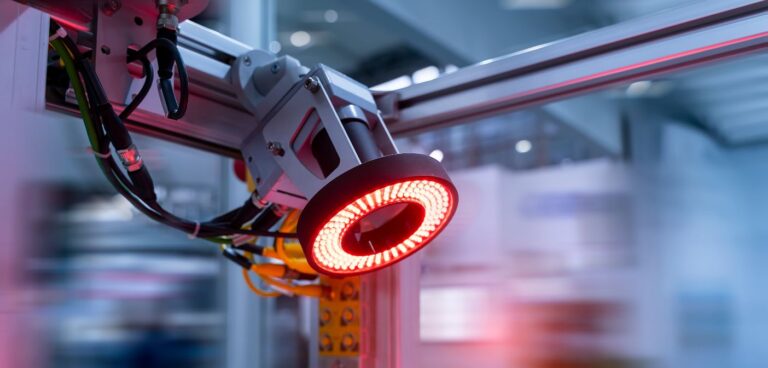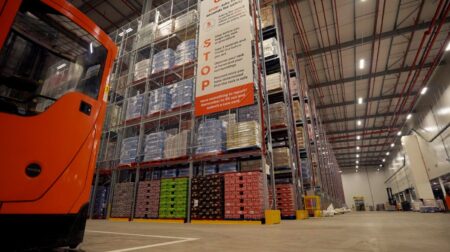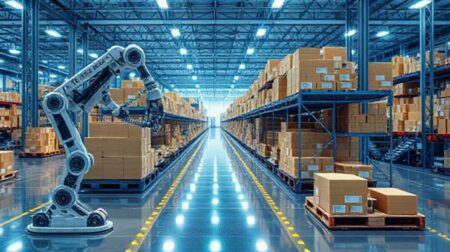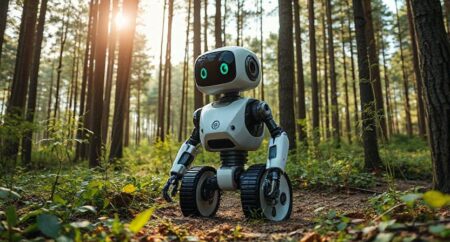Machine vision has been transforming manufacturing and logistics over the past few decades; Michelle Mooney looks at how the technology could speed-up factory and warehouse efficiencies and productivity…
Smart warehouses and factories cannot be smart without smart technologies. And they don’t come much smarter than machine vision, the backbone of many past, present and future intralogistics and manufacturing automation systems, the intelligence of which is advancing all the time.
For instance, this image-based analytics technology is increasingly seeing improvement with the addition of 5G connectivity. “Local 5G mobile networks provide the bandwidth needed for machine vision, while eliminating the need for cables, which is costly if constant replacement is needed”, explains Weiming Chen, innovation manager at Basler, a manufacturer of imaging components for computer vision applications such as cameras, lenses, frame grabbers, software and more.
5G helps to improve connectivity across all the devices used in a warehouse or factory, while reduced cabling helps to save cost on building infrastructure. This type of 5G being ‘local’ also means logistics operators and manufacturers do not need the service of mobile operators – everything is controlled within the warehouse or factory, which helps to improve accuracy across the machine-vision infrastructure.
Bob Driver, head of UK5G at the UK5G Innovation Network, adds that 5G technology can support a “far greater density of sensors and devices”, which makes it possible to monitor a “far greater number of things in an industrial setting”. This might include cameras across the production line, AMRs and AGVs. He adds,
“5G can help to facilitate rapid AI processing of rich data in the cloud, meaning more data can be reviewed and more intricate operations overseen”.
Robot takeover
Machine vision is relatively easy to implement into a factory or warehouse, especially if that facility already has autonomous robots, suggests Nigel Smith of TM Robotics. With both of these technologies together, the autonomous robots can ‘see’ like a human and “readjust to a different shaped product coming down the conveyor, without extensive reprogramming”, Smith explains.
Another dimension
2D and 3D imaging is particularly prevalent in machine-vision technology, and in recent years there has been an identifiable shift from 2D to 3D. And with the advances in lighting technology, Chen explains that supply-chain operators are “seeing the capability to move from passive stereo imaging to light projection imaging such as Time of Flight or structure light”. Chen says the advancement in 3D imaging gives rise to improvements in two key areas: higher depth accuracy and increased working distance, and the expansion of what he refers to as “non-visible wavelength imaging”.
The latter, Chen says, is particularly important in short-wave infrared (SWIR), for which there is growing interest due to “properties such as its non-destructive penetrative capabilities and higher spatial resolution”, which is valuable in many industries such as semi-conductor [logistics], food inspection, identification and sorting and process quality control. The benefits of 3D machine vision are continuously shaping the modern warehouse and factory and improving efficiency, even in unfavourable environments.
Nigel Smith, managing director of TM Robotics, adds that “as machine vision technologies have developed, they’ve become able to deal with the demanding environments of the logistics and manufacturing industries – for example identifying overlapping items in low lighting”. The introduction of 3D vision, he highlights, allows multiple cameras to create a 3D model of the target object.
The company’s ‘TSVision3D’ system operates in this way and, as a result, does not require complex CAD data to recognise objects. In this way, machine vision helps to transform the warehouse and factory into a more efficient system, as robots can adapt quickly to “irregularly shaped items or even completely different ones, without lengthy reprogramming”. It also makes bin picking possible as “the vision system can identify the different products piled up, as well as the correct item to pick first”. Picking accounts for around 50% of warehouse labour spend, so this presents significant cost saving opportunities.
Automated checks
Inspection is another area machine vision can be applied to, as the technology can check for the quality of goods and for damage. This “allows logistics companies and manufacturers to speed-up checking procedures, while enabling complete traceability”, Smith says.
Additionally, John Dunlop, founder of Bytronic Vision Automation, an integrator of machine vision and automated vision inspection, says that whether it’s “for preventative quality inspections, new machine testing, recalls or rejects, demand for rapid inspection has definitely increased since the pandemic”. Part of the cause is staffing problems, as many employees working in logistics or manufacturing were isolating or had other restrictions that prevented them from doing manual checks. The flexibility of automated digital technologies helped reduce costs during the height of the pandemic, and became a “realistic and affordable option”, Dunlop explains.
Quality assurance of goods is big business in the warehouse and factory, and the correct application can ensure that products are in the best shape possible and any mistakes are quickly rectified. This can be done through machine-vision technology, which is generally more accurate and efficient than manual inspection, suggests Ofer Nir, vice president, product and marketing at Inspekto. Because of this, machine vision offers an increased return on investment. Nir also advises that machine vision for quality inspection can minimise these costs.
Specifically, an autonomous machine-vision system that is quick and easy to set up can allow warehouse managers or factory supervisors to re-allocate human inspectors to more productive tasks, while the system takes care of goods quality assurance. Nir adds that the ‘plug and play’ nature of machine-vision systems has eased the complexity of quality assurance checks, as automated machine vision technology can be installed in “a very short period of time”.
Attention to detail
The possibilities of machine vision seem endless. With increased accuracy, better efficiency and faster operations, it’s a wonder why any warehouse or factory wouldn’t adopt this sort of technology. Laith Marmash, EMEA product marketing advisor for machine vision and fixed industrial scanning at Zebra Technologies, explains that if machine vision is used for sortation, the technology will “look” for the courier logo on a package and redirect it to the right line for onward distribution. He adds that machine vision can measure the brightness “or perform a pixel count within a search region on the label”.
Users can define the inspection criteria within a set of limits, and products that exceed these limits will fail when read by the system. “The beauty of this type of automated validation scan is that it can double as a progress report and doesn’t involve any manual intervention, unless the system identifies an issue”, Marmash says.
Deeper insight
Laith Marmash at Zebra Technologies says that “in industrial applications, deep-learning algorithms typically sit on top of existing image acquisition systems, such as fixed scanners
or machine-vision cameras”, and this deep-learning technology allows for a deeper image analysis when paired with machine vision. He cites fabrics on a conveyor as an example – fabrics often have slight natural variations in colour and weave patterns, which are almost impossible for a human operator to quickly assess. In this scenario, machine vision can inspect items at a much faster speed and improve overall accuracy.
All about the result?
The question many logistics managers and manufacturers may have is, ‘How can this product improve my ROI?’ Marmash suggests that, by using machine vision, a production line’s processes can be enhanced and “deep learning models can be enabled in an effective and cost-efficient way”.
The cost of smart cameras and sensors has decreased over the past few years, “while processing power and speed has accelerated dramatically”. The operational efficiency machine vision can provide simply puts ROI in good stead. In addition, explains Chen, when you “enable machines and robots with vision, you allow them to have certain awareness of their environment, which then allows them to perform at higher speeds, have greater flexibility and capacity of functions”.
Currently, machine-vision cameras can run “hundreds of frames per second”, and when AGVs or AMRs are enabled with these cameras, “they can inspect and sort highly mixed products, at very fast speeds, high accuracy within a small floor space”, Chen concludes. This increase in process capacity improves return on investment vastly when compared to a single employee who checks goods manually.
The article was originally published in the July 2022 issue of Robotics & Innovation









